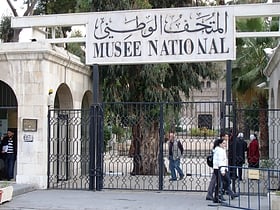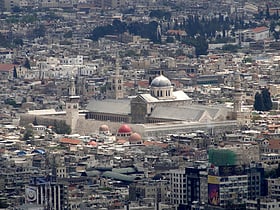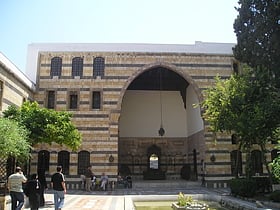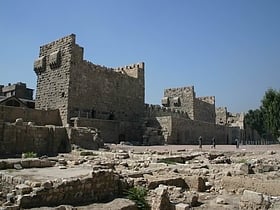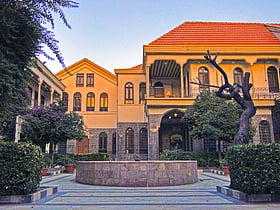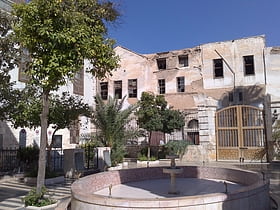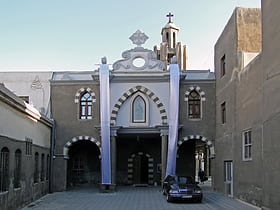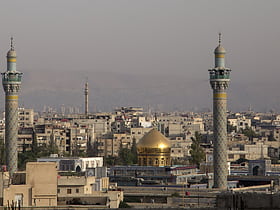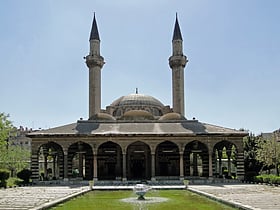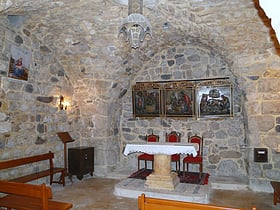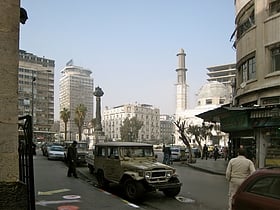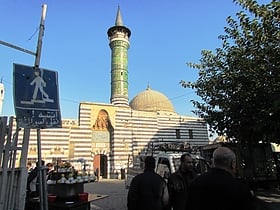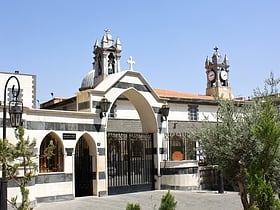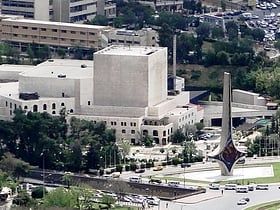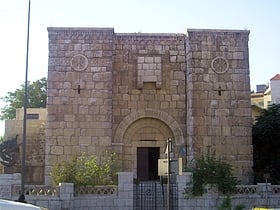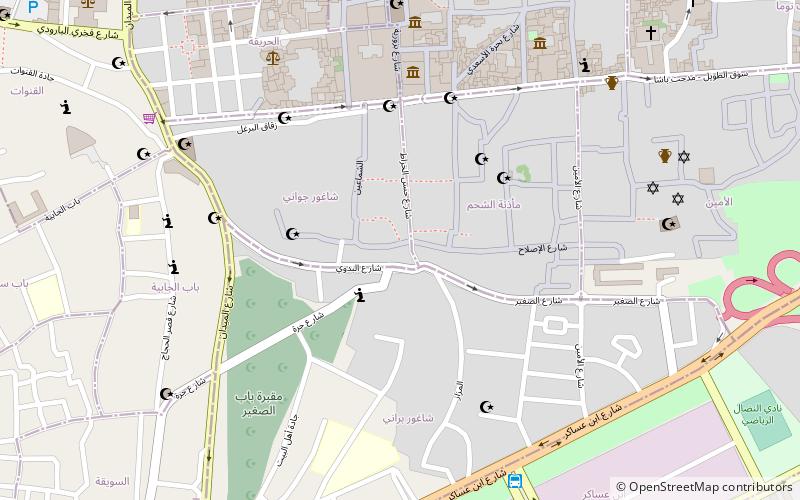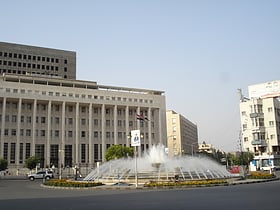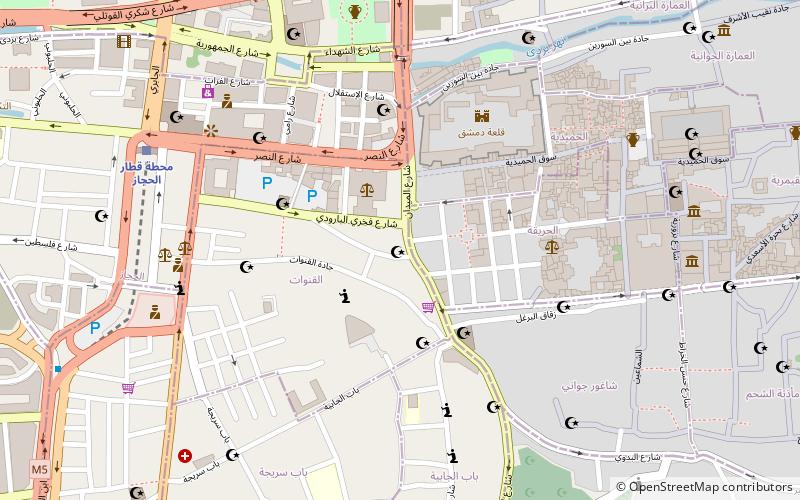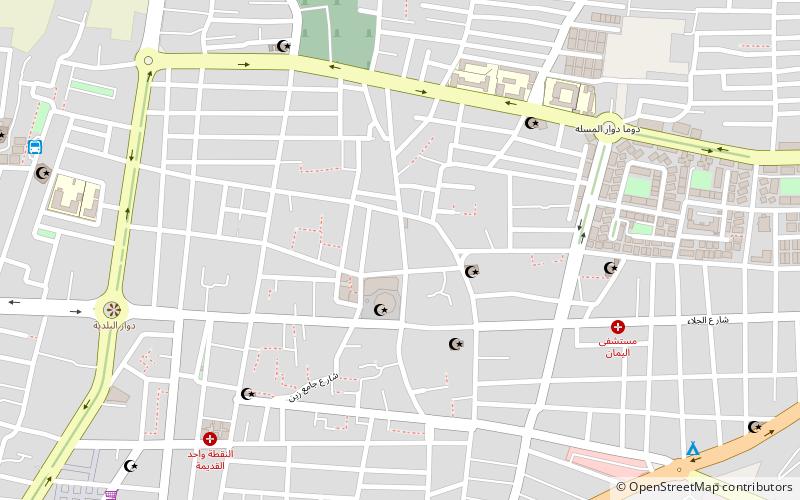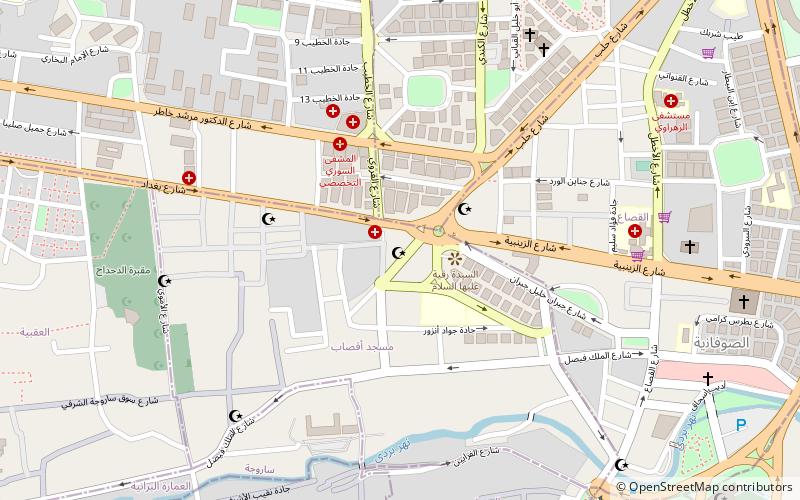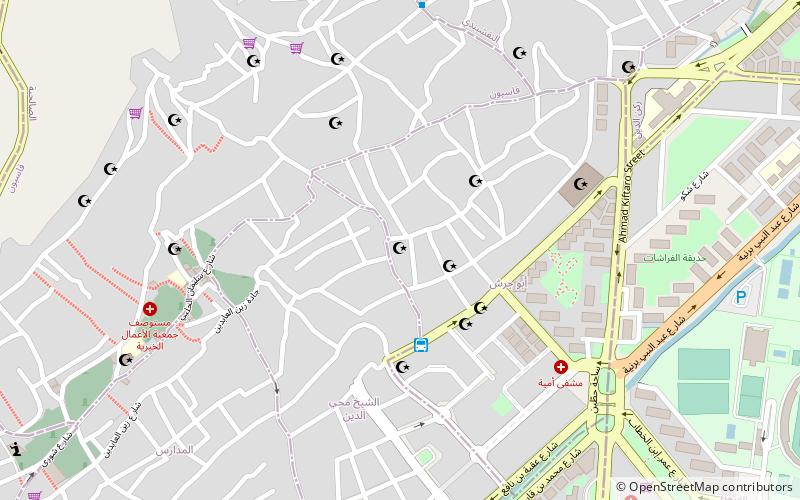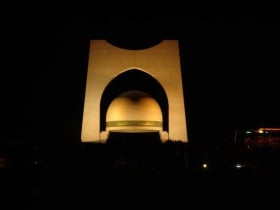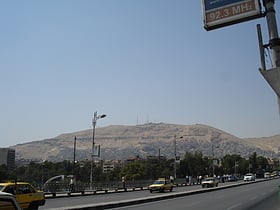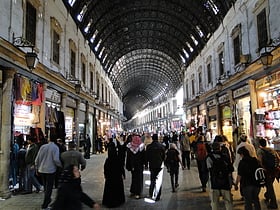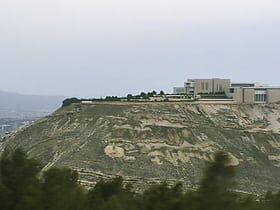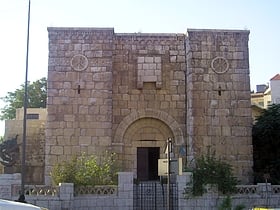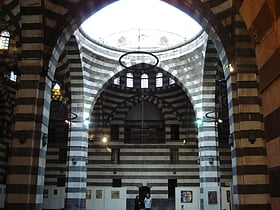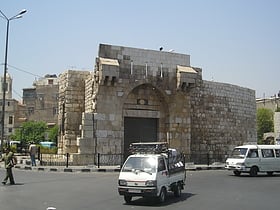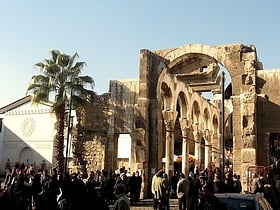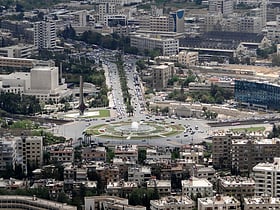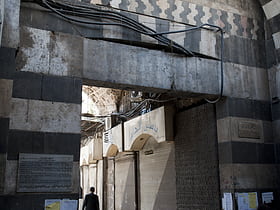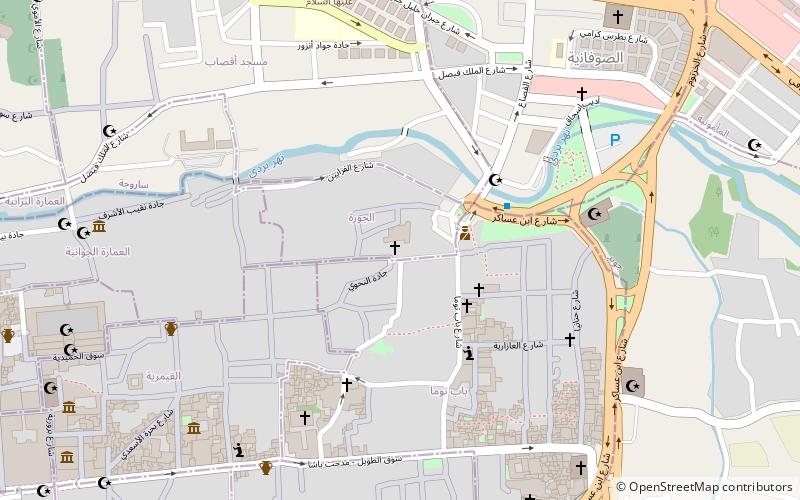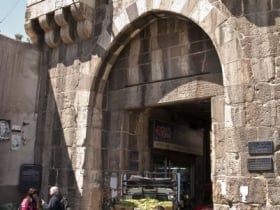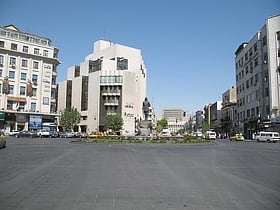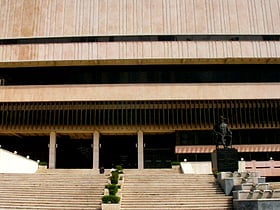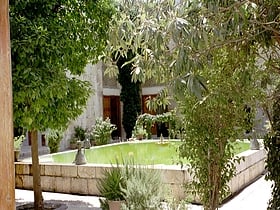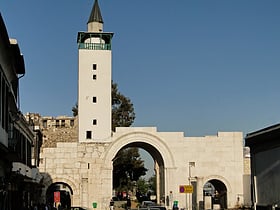Damascus: Sightseeing
Places and attractions in the Sightseeing category
Categories
More categoriesNational Museum of Damascus
Museum of Syrian history and art The National Museum of Damascus stands as a cornerstone of Syrian culture and heritage, located in the heart of the country's capital, Damascus. This prestigious institution is a treasure trove of artifacts and relics that span the rich tapestry of Syrian history, from...
Umayyad Mosque
Landmark ancient mosque and burial site The Umayyad Mosque, also known as the Great Mosque of Damascus, stands as a monumental piece of architecture and a historical treasure in the heart of Damascus, Syria. This mosque is one of the oldest and largest mosques in the world and is considered a masterpiece of...
Azm Palace
Nestled in the heart of Damascus, the Azm Palace stands as a testament to the architectural grandeur and cultural heritage of Syria's capital. This historic palace, an exquisite example of Ottoman-era architecture, was constructed in 1750 under the auspices of the...
Citadel of Damascus
The Citadel of Damascus stands as a formidable testament to the rich history of Damascus, Syria's capital city, and one of the oldest continuously inhabited cities in the world. This historic castle, nestled in the heart of the city, is a captivating blend of various...
Maktab Anbar
Maktab Anbar is an exquisite testament to the rich cultural history nestled in the heart of Damascus, Syria. This 19th-century Ottoman-era palace has been transformed into a museum that captures the essence of Syrian heritage and architecture.
Mausoleum of Saladin
Ancient burial site of a medieval ruler The Mausoleum of Saladin stands as a solemn reminder of the legendary Kurdish leader, Sultan Salah al-Din Yusuf ibn Ayyub, better known in the Western world as Saladin. Located in the ancient city of Damascus, Syria, the mausoleum is a testament to the Sultan’s...
Syriac Catholic Cathedral of Saint Paul
Nestled in the heart of Damascus, the Syriac Catholic Cathedral of Saint Paul stands as an emblem of the city's rich religious tapestry and historical resilience. This sacred edifice, dedicated to Saint Paul who is believed to have been converted to Christianity on the...
Sayyidah Zaynab Mosque
Nestled in the heart of Damascus, the Sayyidah Zaynab Mosque is a revered site of pilgrimage and a testament to the rich religious tapestry of Syria. This mosque is dedicated to Zaynab bint Ali, the granddaughter of the Prophet Muhammad, and sister of Imam Hussein...
Tekkiye Mosque
Nestled in the historic heart of Damascus, Syria, the Tekkiye Mosque stands as a splendid example of Ottoman architecture and a testament to the city's rich cultural tapestry. Constructed in the 16th century under the patronage of Sultan Suleiman the Magnificent, this...
Saint Anania's House
Nestled in the ancient heart of Damascus, Syria, Saint Anania's House is a site of great historical and religious significance. This modest structure is believed to be the location where Ananias of Damascus, a disciple of Jesus, baptized Saul of Tarsus, who would...
Mariamite Cathedral of Damascus
Nestled in the ancient heart of Damascus, Syria, the Mariamite Cathedral of Damascus stands as a beacon of Christian heritage in one of the oldest continuously inhabited cities in the world. This historic church serves as the seat of the Greek Orthodox Church of...
Marjeh Square
Marjeh Square, also known as Martyrs' Square, is a significant landmark situated in the heart of Damascus, Syria. This bustling square is not just a central point in the city's urban grid but also a place steeped in history and cultural importance.
Sinan Pasha Mosque
Nestled in the heart of the ancient city of Damascus, the Sinan Pasha Mosque stands as a testament to the city's rich Islamic heritage. This historic mosque, often overshadowed by the more renowned Umayyad Mosque, is nonetheless an architectural gem in its own right.
Cathedral of the Dormition of Our Lady
Nestled in the ancient city of Damascus, Syria, the Cathedral of the Dormition of Our Lady stands as a testament to the enduring Christian heritage within a tapestry of diverse cultures. This sacred edifice, also known as the Mariamite Cathedral of Damascus, is one of...
Damascus Opera House
The Damascus Opera House, also known as the Syrian Opera House, stands as a cultural beacon in the ancient city of Damascus, Syria. Inaugurated in 2004, this modern edifice has quickly become a symbol of the city's enduring love for the arts amidst a landscape steeped...
Bab al-Saghir
Nestled in the heart of Damascus, Syria, Bab al-Saghir stands as a testament to the city's rich historical tapestry. This ancient cemetery, whose name translates to "Small Gate," is one of the oldest Islamic burial grounds in existence, dating back to the early days of...
St Paul
Nestled in the heart of the ancient city of Damascus, Syria, the Chapel of Saint Paul is a site of great historical and religious significance. This modest church is a tribute to the transformative journey of St. Paul, one of Christianity's most revered apostles.
Bab al-Saghir Cemetery
The Bab al-Saghir Cemetery, resting in the heart of Damascus, Syria, is a site of great historical and spiritual significance. This ancient cemetery is one of the oldest Islamic burial grounds in the world, dating back over a thousand years, and it serves as the final...
Sabaa Bahrat Square
Sabaa Bahrat Square is a historic and iconic public square situated in the heart of Damascus, Syria's capital city. Known for its cultural and political significance, the square has been a focal point of the city's urban landscape for decades.
Darwish Pasha Mosque
Nestled within the ancient streets of Damascus, Syria, stands the historic Darwish Pasha Mosque, a testament to the city's rich Islamic heritage and architectural prowess. This serene place of worship, also known as Darwish Pasha Madrasah, was built in 1574 under the...
Cathedral of Saint George
Nestled within the ancient city of Damascus, the Cathedral of Saint George stands as a testament to the city's rich religious tapestry and historical significance. This sacred edifice is a cornerstone of Christian heritage in the capital of Syria, a place where faith...
Douma
Douma, nestled within the ancient city of Damascus, Syria, is a site steeped in history and marked by recent turmoil. Known as a traditional agricultural center, this city has been inhabited since antiquity, contributing to the rich cultural tapestry of one of the...
Aqsab Mosque
Nestled within the ancient city of Damascus, the Aqsab Mosque stands as a testament to the city's rich Islamic heritage. Known for its architectural beauty and historical significance, this mosque is a cherished landmark in the Syrian capital.
Hanabila Mosque
Nestled in the heart of Damascus, the Hanabila Mosque stands as an emblem of the city's rich historical tapestry and religious heritage. This mosque, though not as grandiose as some of its contemporaries, holds a special place in the hearts of the local community...
Sayyidah Ruqayya Mosque
Nestled in the heart of Damascus, Syria, the Sayyidah Ruqayya Mosque stands as a beacon of spiritual significance and architectural splendor. Dedicated to the daughter of Imam Husayn ibn Ali, Sayyidah Ruqayya bint Al-Husayn, this mosque is a site of pilgrimage for Shia...
Tomb of the Unknown Soldier
In the heart of Damascus, Syria, stands a solemn and evocative monument known as the Tomb of the Unknown Soldier. This poignant memorial is dedicated to the Syrian soldiers who have given their lives for their country without their remains being identified.
Mount Qasioun
Mountain peak known for its city views Mount Qasioun looms over the ancient city of Damascus, Syria, as a sentinel that has witnessed the ebb and flow of civilizations. This mountain is not just a geographical landmark but a historical and cultural beacon that has been part of Damascus's skyline for...
Al-Hamidiyah Souq
Nestled within the heart of Damascus, Al-Hamidiyah Souq stands as a vibrant testament to the city's rich history and cultural tapestry. As one of the oldest and largest covered markets in the world, this bustling street has been a commercial hub for centuries, offering...
Presidential Palace
The Presidential Palace, also known as the People's Palace, stands as an emblem of political power and architectural grandeur in the city of Damascus, Syria. Nestled atop Mount Mezzeh, the palace dominates the skyline, offering a panoramic view of the ancient city...
Bab Kisan
Bab Kisan is one of the seven ancient city-gates of Damascus, Syria. The gate, which is now located in the southeastern part of the Old City, was named in memory of a slave who became famous during a conquest by the Caliph Mu'awiya.
Khan As'ad Pasha
Ornate, historic public bath house Khan As'ad Pasha is the largest Caravanserai in the Old City of Damascus, covering an area of 2,500 square metres. Situated along Al-Buzuriyah Souq, it was built and named after As'ad Pasha al-Azm, the governor of Damascus, in 1751-52.
Bab Tuma
Ancient city gates in old Damascus Bab Tuma is a borough of the Old City of Damascus in Syria, and is also the name of one of the seven gates inside the historical walls of the city, which is a geographic landmark of Early Christianity. The gate was named by the Byzantines to commemorate Saint Thomas the Apostle, one of the twelve apostles of Jesus Christ.
Temple of Jupiter
The Temple of Jupiter in Damascus was built by the Romans, beginning during the rule of Augustus and completed during the rule of Constantius II.
Umayyad Square
Umayyad Square is a large and important square in Damascus, Syria. It connects the city center with several important highways and areas and contains various important buildings including but not limited to the Ministry of Defense, Syria's national Opera house and the headquarters of the Syrian Armed Forces.
Bab al-Faraj
12th-century gate in the city walls Bab al-Faraj also known as Bab al-Bawabijiyah and Bab al-Manakhiliyah is one of the gates of the old city of Damascus in Syria. The gate was built as part of a large program to re-fortify the city following its capture by Nur ad-Din Zangi in 1154.
Our Lady of Soufanieh
Our Lady of Soufanieh refers to Marian apparitions reported to have occurred in Soufanieh, a suburb of Damascus in Syria starting in 1982.
Syriac Catholic cathedral
Syriac Catholic Cathedral of Saint Paul is the cathedral of the Syriac Catholic Church, located in Damascus, Syria. It is the see of the Syriac Catholic Archeparchy of Damascus and is located in the Christian quarter of Damascus, 100 m west of Bab Sharqi.
Armenian Catholic Patriarchal Exarchate of Damascus
The Armenian Catholic Patriarchal Exarchate of Damascus is a pre-diocesan missionary jurisdiction of the Armenian Catholic Church sui iuris in part of Syria.
Bab al-Faradis
12th-century gate on a river bridge Bab al-Faradis or Bab al-Amara is one of the seven ancient city-gates of Damascus, Syria. The other name, Bab Al-Amara, refers to a name of a district in the old city where people in the 14th century would meet.
Yusuf al-Azma Square
Yusuf al-Azma Square, also called al-Muhafaza Square, is an important square in central Damascus, Syria. Named after the late minister of war Yusuf al-Azma where his statue stands in the middle of the square.
Al-Assad National Library
Al-Assad National Library is the national library of Syria, located in the capital Damascus overlooking the Umayyad Square. It's named after Hafez al-Assad. In 1976, Syria's Ministry of Culture issued an official decision to build a national library.
Murad Pasha Mosque
The Murad Pasha Mosque is an early Ottoman-era mosque and mausoleum in Damascus, Syria, located in the Suwayqa sector of the Al-Midan quarter. The mosque was erected and named after Murad Pasha, who served as the Ottoman governor of Damascus between 1568-1569. The mosque was built in 1568.
Nur al-Din Bimaristan
Nur al-Din Bimaristan is a large Muslim medieval bimaristan in Damascus, Syria. It is located in the al-Hariqa quarter in the old walled city, to the southwest of the Umayyad Mosque.
Bab Sharqi
Bab Sharqi, also known as the Gate of the Sun, is one of the seven ancient city gates of Damascus, Syria. Its modern name comes from its location in the eastern side of the city. The gate also gives its name to the Christian quarter surrounding it. The grand facade of the gate was reconstructed in the 1960s.
Map

